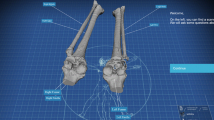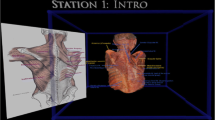Abstract
In medical education, anatomy is typically taught through lectures, cadaver dissection, and using replicas. Advances in VR technology facilitated the development of specialized VR tools for teaching, training, and other tasks. They can provide highly interactive and engaging learning environments where students can immersively and repeatedly inspect and interact with virtual 3D anatomical structures. Moreover, multi-user VR environments can be employed for collaborative learning, which may enhance the learning experience. Concrete applications are still rare, though, and the effect of collaborative learning in VR has not been adequately explored yet. Therefore, we conducted a user study with \(n=\) 33 participants to evaluate the effectiveness of virtual collaboration on the example of anatomy learning (and compared it to individual learning). For our study, we developed an UE4-based multi-user VR anatomy learning application. Our results show that our VR Anatomy Atlas provides an engaging learning experience and is very effective for anatomy learning, individually as well as collaboratively. However, interestingly, we could not find significant advantages for collaborative learning regarding learning effectiveness or motivation, even though the multi-user group spent more time in the learning environment. Although rather high for the single-user condition, the usability tended to be lower for the multi-user group. This may be due to the more complex environment and a higher cognitive load. Thus, more research in collaborative VR for anatomy education is needed to investigate, if and how it can be employed more effectively.
Access this chapter
Tax calculation will be finalised at checkout
Purchases are for personal use only
Similar content being viewed by others
References
de Back, T.T., Tinga, A.M., Nguyen, P., Louwerse, M.M.: Benefits of immersive collaborative learning in CAVE-based virtual reality. Int. J. Educ. Technol. High. Educ. 17, 1–18 (2020)
Barfield, W., Zeltzer, D., Sheridan, T., Slater, M.: Presence and performance within virtual environments. In: Virtual Environments and Advanced Interface Design, pp. 473–513 (1995)
Boedecker, C., et al.: Using virtual 3D-models in surgical planning: workflow of an immersive virtual reality application in liver surgery. Langenbecks Arch. Surg. 406, 911–915 (2021)
Bonali, M., et al.: Surgical instruments and preparation of the specimen. In: Bonali, M., Presutti, L., Marchioni, D. (eds.) Comparative Atlas of Endoscopic Ear Surgery, pp. 9–27. Springer, Cham (2021). https://doi.org/10.1007/978-3-030-47005-0_2
Brooke, J.: SUS: a retrospective. J. Usability Stud. 8(2), 29–40 (2013)
Casey, A., Goodyear, V.A.: Can cooperative learning achieve the four learning outcomes of physical education? A review of literature. Quest 67(1), 56–72 (2015)
Codd, A.M., Choudhury, B.: Virtual reality anatomy: is it comparable with traditional methods in the teaching of human forearm musculoskeletal anatomy? Anat. Sci. Educ. 4(3), 119–125 (2011)
De Back, T.T., Tinga, A.M., Louwerse, M.M.: Learning in immersed collaborative virtual environments: design and implementation. Interact. Learn. Environ., 1–19 (2021)
Estai, M., Bunt, S.: Best teaching practices in anatomy education: a critical review. Ann. Anat.-Anatomischer Anzeiger 208, 151–157 (2016)
Fairén González, M., Farrés, M., Moyes Ardiaca, J., Insa, E.: Virtual reality to teach anatomy. In: Eurographics 2017: Education Papers, pp. 51–58. European Association for Computer Graphics (Eurographics) (2017)
Falah, J., et al.: Virtual reality medical training system for anatomy education. In: 2014 Science and Information Conference, pp. 752–758 (2014)
Fischer, R., Chang, K.-C., Weller, R., Zachmann, G.: Volumetric medical data visualization for collaborative VR environments. In: Bourdot, P., Interrante, V., Kopper, R., Olivier, A.-H., Saito, H., Zachmann, G. (eds.) EuroVR 2020. LNCS, vol. 12499, pp. 178–191. Springer, Cham (2020). https://doi.org/10.1007/978-3-030-62655-6_11
Gloy, K., et al.: Immersive anatomy atlas: learning factual medical knowledge in a virtual reality environment. Anat. Sci. Educ. 15(2), 360–368 (2022)
Guimarães, B., Dourado, L., Tsisar, S., Diniz, J.M., Madeira, M.D., Ferreira, M.A.: Rethinking anatomy: how to overcome challenges of medical education’s evolution. Acta Med. Port. 30(2), 134–140 (2017)
Johnson, D.W., Johnson, R.T., Stanne, M.B.: Cooperative learning methods: a meta-analysis (2000)
Kaluschke, M., Yin, M.S., Haddawy, P., Srimaneekarn, N., Saikaew, P., Zachmann, G.: A shared haptic virtual environment for dental surgical skill training. In: 2021 IEEE Conference on Virtual Reality and 3D User Interfaces Abstracts and Workshops (VRW), pp. 347–352. IEEE (2021)
Keyes, O., Peil, B., Williams, R.M., Spiel, K.: Reimagining (women’s) health: HCI, gender and essentialised embodiment. ACM Trans. Comput.-Hum. Interact. (TOCHI) 27(4), 1–42 (2020)
Kurul, R., Ögün, M.N., Neriman Narin, A., Avci, Ş., Yazgan, B.: An alternative method for anatomy training: immersive virtual reality. Anat. Sci. Educ. 13(5), 648–656 (2020)
Kyndt, E., Raes, E., Lismont, B., Timmers, F., Cascallar, E., Dochy, F.: A meta-analysis of the effects of face-to-face cooperative learning. Do recent studies falsify or verify earlier findings? Educ. Res. Rev. 10, 133–149 (2013)
Laal, M., Ghodsi, S.M.: Benefits of collaborative learning. Procedia. Soc. Behav. Sci. 31, 486–490 (2012)
Lee, J.E., Han, I.H., Kim, S.H., Kim, K.S.: Effectiveness of virtual reality-based learning for anatomy education: a systematic review and meta-analysis. Anat. Sci. Educ. 14(5), 587–600 (2021)
Manzano-León, A., et al.: Development and validation of a questionnaire on motivation for cooperative playful learning strategies. Int. J. Environ. Res. Public Health 18(3), 960 (2021)
Markant, D.B., Ruggeri, A., Gureckis, T.M., Xu, F.: Enhanced memory as a common effect of active learning. Mind Brain Educ. 10(3), 142–152 (2016)
Nokes-Malach, T.J., Richey, J.E., Gadgil, S.: When is it better to learn together? Insights from research on collaborative learning. Educ. Psychol. Rev. 27, 645–656 (2015)
Preim, B., Saalfeld, P., Hansen, C.: Virtual and augmented reality for educational anatomy. In: Uhl, J.-F., Jorge, J., Lopes, D.S., Campos, P.F. (eds.) Digital Anatomy. HIS, pp. 299–324. Springer, Cham (2021). https://doi.org/10.1007/978-3-030-61905-3_16
Reinschluessel, A.V., Muender, T., Salzmann, D., Döring, T., Malaka, R., Weyhe, D.: Virtual reality for surgical planning-evaluation based on two liver tumor resections. Frontiers Surg. 9 (2022)
Roh, T.H., et al.: Virtual dissection of the real brain: integration of photographic 3D models into virtual reality and its effect on neurosurgical resident education. Neurosurg. Focus 51(2), E16 (2021)
Rutherford, S.M.: Collaborative Learning: Theory, Strategies and Educational Benefits. Nova (2014)
Schott, D., et al.: A VR/AR environment for multi-user liver anatomy education. In: 2021 IEEE Virtual Reality and 3D User Interfaces (VR), pp. 296–305 (2021)
Singal, A., Bansal, A., Chaudhary, P.: Cadaverless anatomy: darkness in the times of pandemic covid-19 (2020)
Slater, M.: Immersion and the illusion of presence in virtual reality. Br. J. Psychol. 109(3), 431–433 (2018)
Smith, J., Jones, S.: Anatomy education: classical techniques and modern advancements. Med. Educ. J. 10(2), 50–60 (2020)
Acknowledgment
We express our gratitude to Dr. Verena Uslar and Prof. Dr. med. Dirk Weyhe for their assistance with the anatomy-related questions and tasks. The software used in the study was built on top of the virtual anatomy atlas by Gloy et al. [13].
Author information
Authors and Affiliations
Corresponding author
Editor information
Editors and Affiliations
Rights and permissions
Copyright information
© 2023 The Author(s), under exclusive license to Springer Nature Switzerland AG
About this paper
Cite this paper
Al Maree, H., Fischer, R., Weller, R., Uslar, V., Weyhe, D., Zachmann, G. (2023). Collaborative VR Anatomy Atlas Investigating Multi-user Anatomy Learning. In: Zachmann, G., et al. Virtual Reality and Mixed Reality. EuroXR 2023. Lecture Notes in Computer Science, vol 14410. Springer, Cham. https://doi.org/10.1007/978-3-031-48495-7_8
Download citation
DOI: https://doi.org/10.1007/978-3-031-48495-7_8
Published:
Publisher Name: Springer, Cham
Print ISBN: 978-3-031-48494-0
Online ISBN: 978-3-031-48495-7
eBook Packages: Computer ScienceComputer Science (R0)




